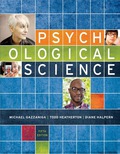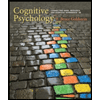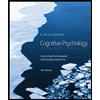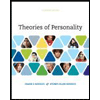
Introduction:
The consciousness makes oneself aware of the environment and able to conclude whether to respond to the factors or not. The activity of the brain to be responsive for an action is called consciousness.
Answer to Problem 1PT
Correct answer:
The key distinction between the person with persistence vegetative state and person with the minimally conscious state is that the person with minimally conscious state will more likely to regain consciousness at some point in the future. Therefore, option (b) is correct.
Option (b) is given as “The person in the minimally conscious state is more likely to regain consciousness at some point in the future”.
Explanation of Solution
Justify reasons for the correct statement:
The global workspace model, states that the consciousness and unconsciousness both are formed by the activity of the brain. The minimal consciousness can be seen in coma patients where the brain activity is less and they are aware of the surrounding even though they are not able to move. They are able to get consciousness any time from days to months or years.
Hence, option (b) is correct.
Justify reasons for the incorrect statements:
Option (a) is given as “the person in the minimally conscious state is less responsive to her or his surrounding”.
When compared with the persistent vegetative state, the person is little aware of his surroundings. Hence, it is a wrong answer.
Option (c) is given as “the person in the minimally conscious state shows some degree of brain activity, whereas the person in the persistent vegetative state shows no brain activity”.
When compared with the persistent vegetative state who has no activity, the person with the minimally conscious state show signs of brain function and able to regain consciousness anytime. Hence, it is a wrong answer.
Option (d) is given as “the person in the minimally conscious state is dreaming, whereas the person in the persistent vegetative state is in a coma”.
The people in the minimal brain activity shows signs of activity and they are little aware of the surrounding, to them the time passed in a coma is like they are dreaming for a long time since there is the activity of the brain. Meanwhile, the patient persistent vegetative state will have no brain activity and to them, there is no dream or anything can be felt. They are in a proper coma. Hence, it is a wrong answer.
Hence, options (a),(c), and (d) are incorrect.
The persistent vegetative state the person only has a little change to regain consciousness with the time period of four to five weeks. If no brain activity is observed after that period, they are regarded as a persistent vegetative state. Whereas, a person with minimal consciousness have brain activity and are able to regain consciousness anytime in future.
Want to see more full solutions like this?
Chapter 4 Solutions
EBK PSYCHOLOGICAL SCIENCE (FIFTH EDITIO
- Can excessive use of social media has been linked to increased levels of anxiety, depression, and loneliness, particularly among younger users?arrow_forwardHow exposure to diverse cultures and ideas broadens one's perspective of the world, yet it can also result in cultural appropriation or homogeneity?arrow_forwardHow to develop a proposal outline with examples on How Social Media Influences Human Behavior.arrow_forward
- While reading this article can you explain strong point , weaknesses point an future study https://doi.org/10.1126/science.1182238arrow_forwardWhat are your thoughts of this article https://doi.org/10.1126/science.1182238arrow_forwardWhile readings this article what does this explain about the people https://doi.org/10.1126/science.1182238arrow_forward
- Make a graph based on this data below : based on group A and Group B Group A (Bilingual): Vocabulary Task Response Times (seconds): [1.1, 1.3, 1.2, 1.0, 1.4, 1.3, 1.2, 1.1, 1.0, 1.2] Sentence Construction Task Response Times (seconds): [2.0, 2.1, 1.9, 1.8, 2.2, 2.1, 1.7, 2.0, 1.8, 1.9] Group B (Monolingual): Vocabulary Task Response Times (seconds): [1.5, 1.6, 1.5, 1.4, 1.7, 1.5, 1.8, 1.6, 1.5, 1.6] Sentence Construction Task Response Times (seconds): [2.5, 2.6, 2.5, 2.7, 2.4, 2.6, 2.7, 2.5, 2.5, 2.6] 2. Outcome of the Experiment The outcome showed that bilingual individuals performed better, with faster response times in both vocabulary retrieval and sentence construction tasks compared to monolingual individuals. 3. Descriptive Statistics Group A (Bilingual): Vocabulary Task: Mean: Mean=10(1.1+1.3+1.2+1.0+1.4+1.3+1.2+1.1+1.0+1.2)=1.21s Standard Deviation (SD): SD≈0.11s Sentence Construction Task: Mean: Mean=10(2.0+2.1+1.9+1.8+2.2+2.1+1.7+2.0+1.8+1.9)=1.99s SD:…arrow_forwardIn this article, can you explain each of the three games ultimatum game, the dictator game, and the party punishment game? Also, how many days did they play the game, and did people know about it? https://doi.org/10.1126/science.1182238arrow_forwardIn this article can you describe the fairness an punishment for market, religion and community https://doi.org/10.1126/science.1182238arrow_forward
- In this article what was the advantage an disadvantage of this article and what was the point of the article. https://doi.org/10.1126/science.1182238arrow_forwardIn this article what was the method and what was the results https://doi.org/10.1126/science.1182238arrow_forwardCan you help me find 10 interested discussion topics on evolutionary psychology &culturearrow_forward
 Ciccarelli: Psychology_5 (5th Edition)PsychologyISBN:9780134477961Author:Saundra K. Ciccarelli, J. Noland WhitePublisher:PEARSON
Ciccarelli: Psychology_5 (5th Edition)PsychologyISBN:9780134477961Author:Saundra K. Ciccarelli, J. Noland WhitePublisher:PEARSON Cognitive PsychologyPsychologyISBN:9781337408271Author:Goldstein, E. Bruce.Publisher:Cengage Learning,
Cognitive PsychologyPsychologyISBN:9781337408271Author:Goldstein, E. Bruce.Publisher:Cengage Learning, Introduction to Psychology: Gateways to Mind and ...PsychologyISBN:9781337565691Author:Dennis Coon, John O. Mitterer, Tanya S. MartiniPublisher:Cengage Learning
Introduction to Psychology: Gateways to Mind and ...PsychologyISBN:9781337565691Author:Dennis Coon, John O. Mitterer, Tanya S. MartiniPublisher:Cengage Learning Psychology in Your Life (Second Edition)PsychologyISBN:9780393265156Author:Sarah Grison, Michael GazzanigaPublisher:W. W. Norton & Company
Psychology in Your Life (Second Edition)PsychologyISBN:9780393265156Author:Sarah Grison, Michael GazzanigaPublisher:W. W. Norton & Company Cognitive Psychology: Connecting Mind, Research a...PsychologyISBN:9781285763880Author:E. Bruce GoldsteinPublisher:Cengage Learning
Cognitive Psychology: Connecting Mind, Research a...PsychologyISBN:9781285763880Author:E. Bruce GoldsteinPublisher:Cengage Learning Theories of Personality (MindTap Course List)PsychologyISBN:9781305652958Author:Duane P. Schultz, Sydney Ellen SchultzPublisher:Cengage Learning
Theories of Personality (MindTap Course List)PsychologyISBN:9781305652958Author:Duane P. Schultz, Sydney Ellen SchultzPublisher:Cengage Learning





